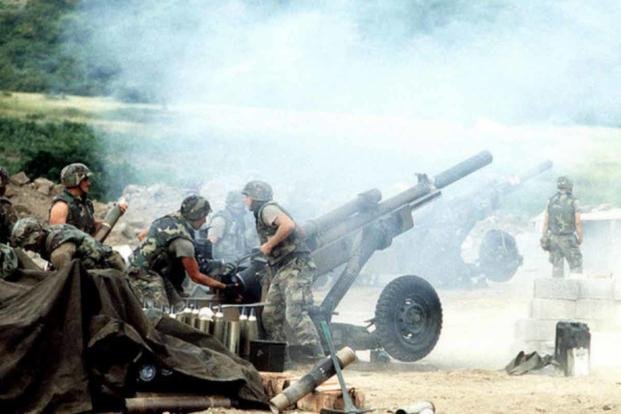Think of it as "Improvise, Adapt, Overcome" on a grand strategic scale.
When word came down that U.S. Army troops would be shipping out soon after the U.S. Marine Corps barracks in Beirut were blown up on Oct. 23, 1983, by the Islamic terrorist group Hezbollah, killing 241 service members, military leaders assumed they were invading Lebanon.
But they soon learned that "Operation Urgent Fury" meant a U.S. invasion of Grenada, a tiny Caribbean island tucked away between Puerto Rico and Venezuela. They were forced to pivot.
The U.S. military knew so little about the country, it had to plan the invasion using maps normally sold to tourists.
Grenada had secured independence from the United Kingdom nine years earlier. At the time, no one imagined it could end up as the staging area for Soviet military operations in the Western Hemisphere.

Grenada's independence didn't bring unity and peace in the streets. There was widespread unrest in the island nation after the United Kingdom granted its independence, and the first government was overthrown by Marxist-Leninist dictator Maurice Bishop.
After he took power, the country's relationship with communist Cuba grew closer. Yet Bishop made friendly overtures to the United States, which would prove to be part of his downfall.
Not long after Bishop took power, the Cuban government helped him build a large airfield in Grenada, a project that raised a lot of eyebrows, especially in Washington. Port Salines Airport, on the southern tip of the island, had runways just big enough to support the largest of the Soviet Union's aircraft.
It seems strange to assume that an airport designed by a Canadian firm on a tiny island would be the object of suspicion to the western powers, but American intelligence immediately deemed it a national security threat.
Then, Bishop was hunted and executed by a hard-line faction of his own party on Oct. 19, 1983. For the island's democratic neighbors and U.S. President Ronald Reagan, that was just too much.
Reagan had other reasons to be concerned about Grenada. In the aftermath of the bloody coup, 600 American medical students were known to be on the island. With the memory of the Iran Hostage Crisis still fresh, he wanted to ensure there would be no repeats.
The U.S. military knew very little about the island or its geography. According to "The U.S. Invasion of Grenada: Legacy of a Flawed Victory" by author Philip Kukielski, Army personnel had to go to downtown Fayetteville, North Carolina, to purchase tourist maps of the island so planners could outline the invasion after drawing military grid reference lines over them. Photocopies of the maps were handed out to troops after coordinates and even the airport were hand-drawn on them.
These pre-internet war planners also had to buy issues of "The Economist," so they could get some kind of intelligence on the country.
Invading Grenada, a communist country, wasn't without risk. The government was supported by America's Cold War rival, the Soviet Union, and its allies. Cuban troops were already stationed on the island. But in the end, no one was coming to help the new Grenadian government.
The murdered Bishop and Cuban dictator Fidel Castro had been more than political allies; they were friends. And Moscow wasn't willing to risk World War III over an island with no strategic value.
With the exception of a handful of Cuban "citizen soldiers" and some Eastern Bloc advisers, Grenada was pretty much on its own against the United States.
And the U.S. military, still smarting from the failed "Desert One" operation to rescue the hostages in Iran, as well as the lingering specter of Vietnam, was ready for a swift show of force.
Operation Urgent Fury was pretty much like pitting the Harlem Globetrotters against a junior high school team.

Navy SEALs reconnoitered Port Salines with Air Force combat controllers. The 75th Ranger Regiment conducted an air assault to capture the newly constructed airport and anti-air guns and neutralize Cuban special forces. The U.S. Army's Delta Force helped liberate political prisoners, while U.S. Marines made an amphibious landing on the other side of the island to relieve pressure on the SEALs.
That was just the first day.
The 82nd Airborne landed to secure the airfield's perimeter and rescue the medical students, as Army infantry fought to capture the main Cuban compound on the island. Marines and soldiers rolled up any remaining resistance on the coasts as the last defenders of the island deserted or surrendered.
Despite its overwhelming success, the invasion was not without its faults. Aside from the lack of planning capability and intelligence, communication issues between the services were apparent. Artillery, naval gunfire and close-air support missions killed friendly forces throughout the three-day invasion.
Other issues included Navy SEALs getting lost at sea, Army Rangers being left behind and a general lack of coordination between forces.
The result was the Goldwater-Nichols Act, which reorganized the Department of Defense and military forces, streamlining the chain of command.
Instead of the service chiefs independently reporting to the secretary of defense, the Joint Chiefs of Staff now report through the chairman or a unified combatant commander.
By the next time the U.S. military was called up to intervene in the Western Hemisphere -- the U.S. invasion of Panama in 1989 -- everything went according to plan, without purchasing any issues of "The Economist."
-- Blake Stilwell can be reached at blake.stilwell@military.com. He can also be found on Twitter @blakestilwell or on Facebook.
Want to Learn More About Military Life?
Whether you're thinking of joining the military, looking for post-military careers or keeping up with military life and benefits, Military.com has you covered. Subscribe to Military.com to have military news, updates and resources delivered directly to your inbox.
















